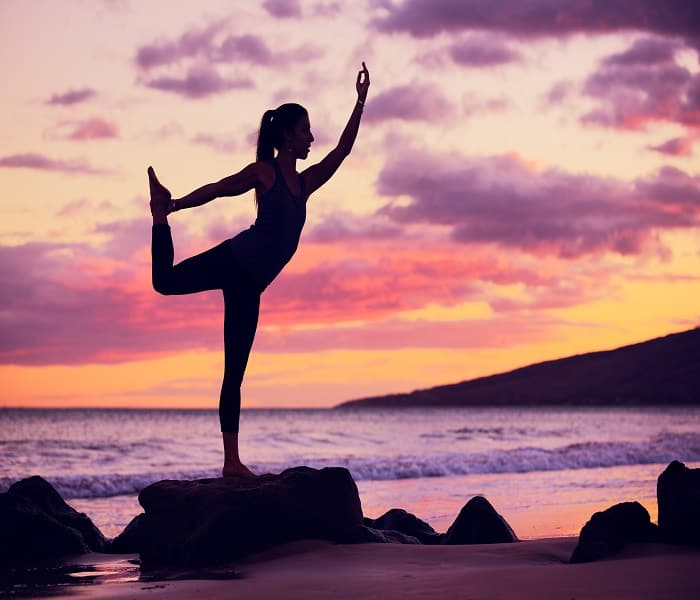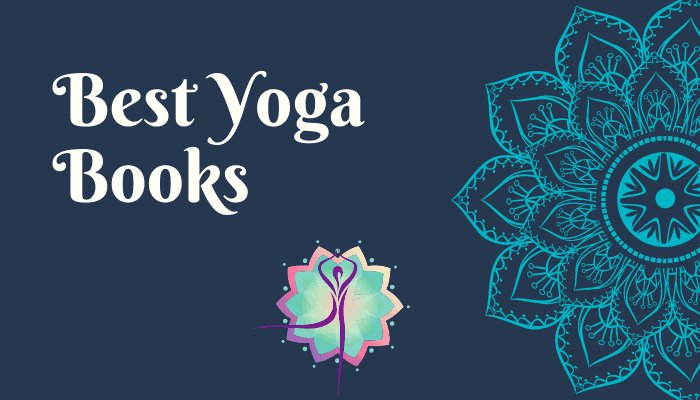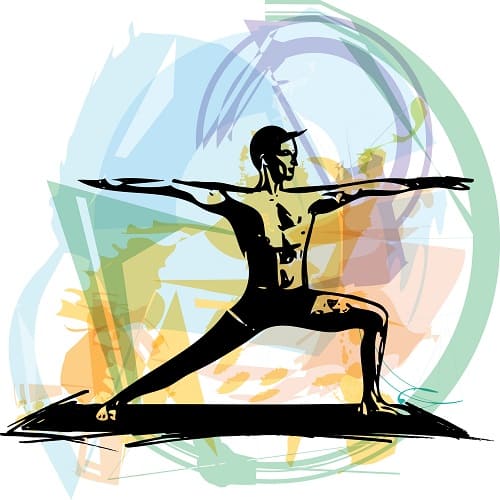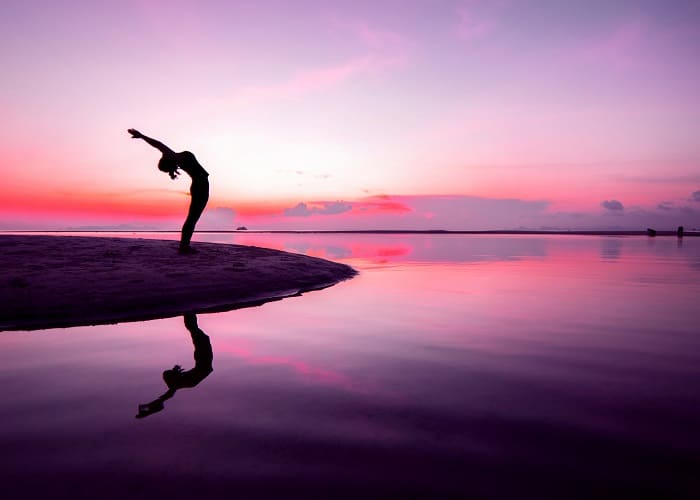
On the surface, Ashtanga and Vinyasa yoga may seem to be similar, but in fact, there are a lot of significant differences between them.
While both of them incorporate breath with movement, they are distinct practices.
Ashtanga History
The term Ashtanga comes from the Sanskrit root words “asht,” which means “eight” and “anga,” which means “limb.”
The term Ashtanga, or Eight Limbs, was first mentioned in The Yoga Sutras of Patanjali, written around 400 CE.
In the Yoga Sutras, Patanjali outlines the eight limbs or branches of yoga practice as being the yamas and niyamas (code of ethics and observances), asana (yoga postures), pranayama (yogic breathing), pratyahara (withdrawal of the senses), dharana (one-pointed concentration), dhyana (meditation) and samadhi (complete absorption).
Inventor of Ashtanga Yoga, Sri Pattahbi Jois said that the third limb, asana, or yoga postures, needed to be practiced first in order to be able to fully master the other limbs.
Ashtanga and its series were first taught by Sri Pattahbi Jois who learned the sequences from his guru Krishnamacarya in Mysore, India.
Jois founded a center in Mysore called the Ashtanga Yoga Research Institute where students can go to learn the traditional Ashtanga practice.
Though Jois died in 2009, the institute is still open today, with his family members and former students carrying on the tradition of Ashtanga teaching.
How is Ashtanga practiced?
Ashtanga has six series in total: The Primary Series, Intermediate Series, Advanced Series and then Advanced A, B, C and D series.
Patthabi Jois promoted what has come to be called Mysore style of teaching, where students perform the postures of the series at their own pace during class and the teacher observes and assists the students in performing the postures as they practice at their individual levels.
Only after the student has proven that they are capable of mastering all of the postures in a series does the teacher grant permission to begin practicing the next series.
Today, Ashtanga is taught differently.
While some schools continue to teach the traditional Mysore style, today it’s more common to find Ashtanga classes that are taught with the teacher guiding the students through the series with the whole class practicing the sequence together.
In a typical Western Ashtanga class, only the Primary series is taught.
The practice of Ashtanga also incorporates three areas of attention, called the tristhana: breath (pranayama), posture (asana) and focal point (drishti).
As students practice, they master these three areas with more fluidity over time.
Ashtanga also has a traditional opening chant, chanted by the teacher and students:
vande gurūṇāṁ caraṇāravinde
saṁdarśita-svātma-sukhāvabodhe
niḥśreyase jāṅ̇galikāyamāne
saṁsāra-hālāhala-mohaśāntyai
ābāhu puruṣākāraṁ
śaṅ̇kha-cakrāsi-dhāriṇam
sahasra-śirasaṁ śvetam
praṇamāmi patañjalim
I bow to the lotus feet of the gurus,
The awakening happiness of one’s own-self revealed,
Beyond better, acting like the jungle physician,
Pacifying delusion, the poison of Samsara.
Taking the form of a man to the shoulders,
Holding a conch, a discus, and a sword,
One thousand heads white,
To Patanjali, I salute.
There is also a traditional closing chant:
svasti prajābhyaḥ paripālayantāṁ nyāyena mārgeṇa mahīṁ mahīśāḥ
go-brāhmaṇebhyaḥ śubham astu nityaṁ lokāḥ samastāḥ sukhino bhavantu
May all be well with mankind,
May the leaders of the Earth protect in every way by keeping to the right path.
May there be goodness for those who know the Earth to be sacred.
May all beings be happy.
Popular Ashtanga teachers
Western Ashtanga students such as Nancy Gilgoff, David Swenson and more recently, Kino MacGregor, have popularized the practice of Ashtanga and today there are many studios worldwide that offer Ashtanga classes.
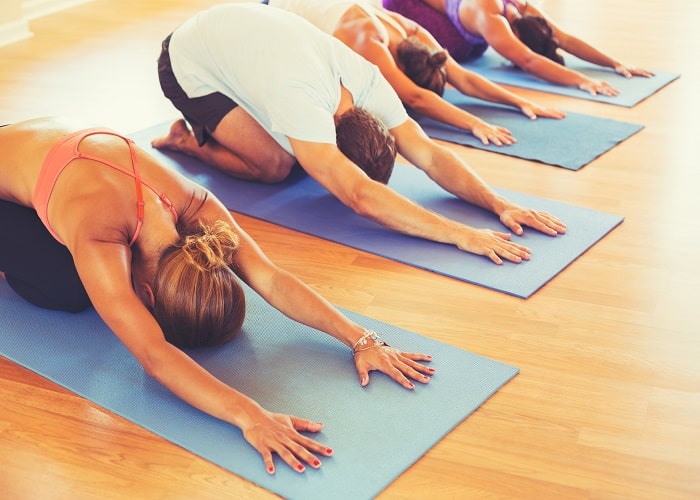
Vinyasa History
Vinyasa comes from the Sanskrit prefix “vi” meaning “in a special way” and “nyasa” meaning “to place”, hence, the term Vinyasa means “to place in a special way.”
This “special way” refers to the focus on conscious movement that combines breath with motion that is characteristic of a Vinyasa class.
Students are encouraged to stay with the breath and use the breath as a guide as they move through the postures.
Staying present, finding fluidity in the movements and connecting to the breath are signature traits of a Vinyasa class.
It is sometimes speculated that Indian Rishi Vamana invented Vinyasa yoga with the aim of combining yoga postures, mudras, pranayama, meditation and japa.
A modern class may include some of these components, but it’s up to the teacher to include these elements or not.
How is Vinyasa practiced?
A Vinyasa class generally keeps its students moving in a steady flow from start to finish as they move through sequences designed by the teacher.
Unlike in Ashtanga, the sequences of a Vinyasa class are different every time and can be beginner or advanced level, depending on the teacher.
Remember that in Ashtanga, the sequences are always the same.
Surya Namaskar- Sun Salutations
That being said, both Vinyasa and Ashtanga make use of the Surya Namaskar sequence, or Sun Salutation, which is a specific series of postures:
- Standing pose (Tadasana or Samasthiti)
- Arms overhead (Urdhva Hastasana)
- Standing Forward Bend (Uttanasana)
- Half Standing Forward Bend (Ardha Uttanasana)
- Plank pose (Chaturanga Dandasana)
- Upward Facing Dog (Urdva Mukha Svanasana)
- Downward Facing Dog (Adho Mukha Svanasana)
- Standing Forward Bend (Uttanasana)
- Arms overhead (Urdhva Hastasana)
- Standing pose (Tadasana or Samasthiti)
Sun Salutations sometimes have variations in Vinyasa classes, and they can be repeated several times as a warm-up for the rest of class.
Some traditions encourage students to practice 108 Sun Salutations during the change of the seasons to purify the body and bring good health and an auspicious new season.
- Arms overhead (Urdhva Hastasana)
- Standing Forward Bend (Uttanasana)
- Half Standing Forward Bend (Ardha Uttanasana)
- Plank pose (Chaturanga Dandasana)
- Upward Facing Dog (Urdva Mukha Svanasana)
- Downward Facing Dog (Adho Mukha Svanasana)
- Standing Forward Bend (Uttanasana)
- Arms overhead (Urdhva Hastasana)
- Standing pose (Tadasana or Samasthiti)
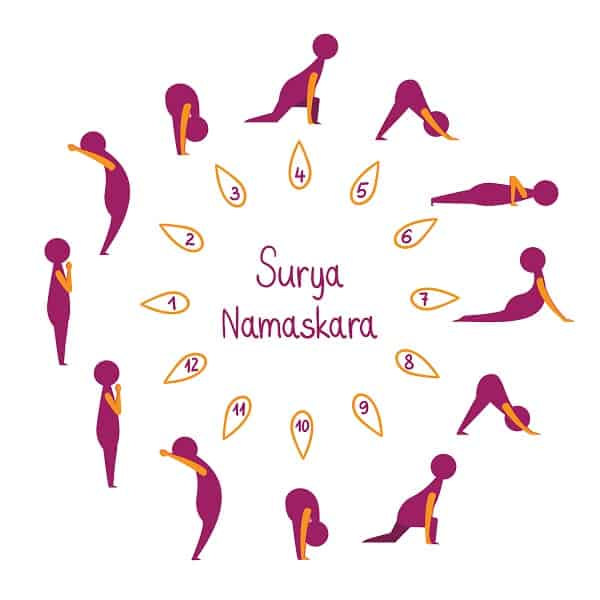
The Evolution of Vinyasa
Baron Baptiste popularized Power Yoga in the ‘90s, a spinoff of Vinyasa yoga with shorter, high-intensity sequences that aimed to build strength and flexibility quickly.
Though Baptiste intensified the practice with his high-power sequences, Vinyasa has the reputation for being a highly aerobic practice already as students flow from posture to posture without breaks, keeping the heart rate high and students will often break a sweat in class.
Unlike Ashtanga, Vinyasa is seen as a more Westernized form of yoga.
Without a specific guru who championed it like Sri Pattabhi Jois for Ashtanga and B.K.S. Iyengar for Iyengar, modern Vinyasa doesn’t respect a specific lineage.
Traditional Ashtanga schools, for example, don’t practice on the full and new moon, whereas Vinyasa classes generally don’t have this tradition, nor are there specific mantras associated with Vinyasa classes.
Also, a Vinyasa teacher may play music to help students find energy and flow, whereas there is no music in an Ashtanga class.
Take a vinyasa
While Vinyasa is a style of yoga, it is also the name of a specific sequence commonly performed in yoga classes.
You will often hear a command from teachers in Ashtanga and Vinyasa classes and even in other styles of classes, “Take a vinyasa.”
This refers to a sequence of three postures:
- Chaturanga Dandasana – Plank pose
- Urdhva Mukha Svanasana – Upward Dog pose
- Adho Mukha Svanasana – Downward Dog pose
This sequence is used as a transition between poses in Ashtanga classes.
In Vinyasa classes, this sequence is used frequently to build heat.
Popular Vinyasa teachers
Vinyasa teachers such as Rusty Wells, Shiva Rhea and Jason Crandell are popular Vinyasa yoga teachers in the West and Vinyasa is a very popular style of yoga with many students.
Summary of similarities and differences
Let’s break down the similarities and differences between Ashtanga and Vinyasa style yoga:
Similarities:
- Both combine breath with movement.
- Both use the 3-pose vinyasa sequence during class.
- Both can be vigorous aerobic exercises.
Differences:
- Ashtanga follows a specific series of postures whereas each Vinyasa class has a different series designed by the teacher.
- Ashtanga has a specific lineage in India and a center where students can go to learn the traditional style whereas Vinyasa is largely seen as a Westernized style of yoga.
- Ashtanga has specific mantras chanted to open and close the class whereas Vinyasa doesn’t have a specific mantra.

Should you practice Ashtanga or Vinyasa?
The Ashtanga Primary Series, though only the first series, actually has quite a few advanced postures and requires a significant amount of flexibility in order to perform them.
Though you can do modifications and traditionally students are encouraged to skip postures that their bodies are not yet prepared to perform, the series is quite rigorous for those who lack strength or flexibility.
In this case, it might be better to start with some low-intensity or beginner level Vinyasa classes to build strength and flexibility and then try Ashtanga classes.
Some students try Ashtanga and get bored with the repetition of the same series each time.
With Vinyasa, each class will be different, so students will enjoy a more dynamic exploration of the different poses.
Whichever style of yoga you choose to practice, remember to respect your body’s limits and don’t attempt to push through pain in order to do a pose.
That’s often how students get injured in yoga classes.
On the other hand, the practice of yoga postures like those performed in Ashtanga and Vinyasa classes, has many health and wellness benefits, from increasing strength and flexibility, expanding lung capacity due to the emphasis on deep breathing and calming the mind.
Many students in the West come to yoga as a physical practice and eventually decide they want to delve deeper into understanding the traditions and philosophy and see it as a path for self-knowledge.
If you’re new to yoga, welcome to this wonderful tradition for health and self-realization.
You may also be interested in:
1. Is Yoga Enough to Stay Fit?
